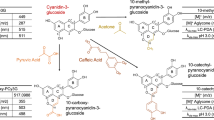Abstract
Forsyth and Roberts1 reported that chromatographically homogeneous cacao proanthocyanidin dimer yielded epicathechin and a new leucocyanidin when heated with 0.1 N hydrochloric acid, and cyanidin when heated with stronger acid. Similar dimeric proanthocyanidins were isolated from Crataegus oxyacantha and Gleditschia triacanthos by Freudenberg and Weinges2–5. The astringent proanthocyanidins isolated from various fruit tissues, unlike the above dimers, were found to be highly polymerized and not chromatographically mobile. This was true of the originally isolated persimmon proanthocyanidin6,7 and of the more recently isolated persimmon8 and apple9 preparations. These purified preparations, which were not mobile on paper in any of the solvent systems tested, were, however, found to yield mobile phenolics without any accompanying anthocyanidins when heated with dilute hydrochloric acid. Under these conditions several chromatographically identified phenolics and a non-mobile but apparently less highly polymerized fraction were obtained. The original preparation, and the residue after dilute acid hydrolysis, which was insoluble in ethyl acetate, were found to yield identifiable anthocyanidins on heating with more concentrated hydrochloric acid. The results of these observations, which continued investigations previously reported on the mechanism of acid conversion of proanthocyanidins into their corresponding anthocyanidins10, are reported here.
This is a preview of subscription content, access via your institution
Access options
Subscribe to this journal
Receive 51 print issues and online access
$199.00 per year
only $3.90 per issue
Buy this article
- Purchase on Springer Link
- Instant access to full article PDF
Prices may be subject to local taxes which are calculated during checkout
Similar content being viewed by others
References
Forsyth, W. G. C., and Roberts, J. B., Biochem. J., 74, 374 (1960).
Freudenberg, K., Experientia, 16, 107 (1960).
Freudenberg, K., and Weinges, K., Tetrahedron Letters, 8, 267 (1961).
Weignes, K., Chem. Ber., 94, 3032 (1961).
Freudenberg, K., and Weinges, K., Angew. Chem., 74, 182 (1962).
Ito, S., and Oshima, Y., Agric. Biol. Chem., 26, 156 (1962).
Ito, S., Bull. Hort. Res. Sta., Japan, Ser. B., No. 1 (1962).
Joslyn, M. A., and Goldstein, J., J. Agric. Food Chem. (in the press).
Ito, S., and Joslyn, M. A., J. Food Sci. (in the press).
Joslyn, M. A., and Goldstein, J., Science, 143, 954 (1964).
Hillis, W. E., and Swain, T., J. Sci. Food Agric., 10, 533 (1959).
Author information
Authors and Affiliations
Rights and permissions
About this article
Cite this article
ITO, S., JOSLYN, M. Presence of Several Phenolic Components in Fruit Proanthocyanidins. Nature 204, 475–476 (1964). https://doi.org/10.1038/204475a0
Issue Date:
DOI: https://doi.org/10.1038/204475a0
This article is cited by
-
Chemical structures of the condensed tannins in the fruits ofDiospyros species
Journal of Wood Science (2002)
-
Gaschromatographische Bestimmung der Inhaltsstoffe von G�rungsgetr�nken
Zeitschrift f�r Lebensmittel-Untersuchung und -Forschung (1976)
-
Local plants as potential sources of tannins in Egypt. Part V (Lauraceae to Meliaceae)
Qualitas Plantarum et Materiae Vegetabiles (1971)
-
Local plants as potential sources of tannins in Egypt. Part VI (Moraceae to Rosaceae)
Qualitas Plantarum et Materiae Vegetabiles (1971)
-
Local plants as potential sources of tannins in Egypt. Part VII (Rubiaceae to Vitaceae)
Qualitas Plantarum et Materiae Vegetabiles (1971)
Comments
By submitting a comment you agree to abide by our Terms and Community Guidelines. If you find something abusive or that does not comply with our terms or guidelines please flag it as inappropriate.



